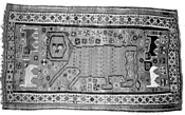It's a gritty and often drab existence, in which survival demands constant hard, physical labor. Everyday items are handmade -- not in a Martha Stewart "Aren't crafts fun?" kinda way, but because that's the only way to have them. In this life, all things must be useful, so it's a tribute to the human spirit that any creativity comes through at all.
This show suggests, however, that the individual artist faces a greater challenge than being limited to making useful items. The works must also conform to patterns and motifs determined by tribe and religion (usually Muslim). The Renaissance spirit that turned the focus of Western art to celebration of the individual has no place in this world. The artists, primarily women, whose works hang in the Ellen Johnson Gallery are invisible.
What is visible tends to educate more than delight. The works conform to a series of similar patterns and colors, revealing only flashes of whimsy. Their utilitarian aspects are apparent: Rugs are hung before tent openings, to keep out blowing sand and wandering animals; jumbo-sized bags are used to haul bedding and cooking pots; a worn and spot-cleaned eating rug protects better carpets underneath from mealtime dribbles. Almost everything is in stain-hiding, dirt-resistant red, orange, brown, black, or tan -- with a red or blue accent here or there.
The star of the show is the "Qashqai Rug" of wool, a gift to the college from the late Oberlin art professor and patron extraordinaire Ellen Johnson. This area rug sports a handsome orange lion, with heavy eyebrows, prancing sideways. The lion, whose charming face looks somewhat puzzled, and four smaller creatures (more lions? prey?) all look like Etch-a-Sketch figures on a burnt-orange bed of geometric designs.
A woman's Turkoman cloak shows some frivolity. Made of cotton with silk embroidery, it has fake sleeves in the back, giving the effect of a tennis sweater tossed over the shoulders. Harnesses and other animal accessories show a playful urge to decorate. There's an elaborate Yomud flank cover, with a diamond pattern in deep red and brown tones with fringe on the edges, and a lovely wool-and-horsehair-braided halter from the Baluch tribe.
A South Caucasian brocaded wool cover (used to put over packed household goods or to keep rodents out) boasts an intriguing design of four rows of block "S" shapes -- one side of the piece the mirror image of the other. Inside each square block, smaller rows in a houndstooth-type pattern add texture and interest. It appears that the weaver worked on a small, portable loom and then joined the two sections together with a vertical seam.
Contributing to the educational quality of this exhibition is a 1976 video, People of the Wind, based on the semi-annual migration of the Babadi Bakhtiyari tribe. The video depicts sheep being pushed into a stream and a wailing, reluctant bride being urged into marriage. Tribal music is piped into the gallery, and a full-sized, furnished Baluch tent is assembled on the floor. The tent, while off-limits to visitors, nonetheless entices one to crawl in and imagine what it would be like to live there. A free exhibition catalog features glossy pictures and an informative commentary by curator Charles Q. Mason.
The show is limited in its ability to educate viewers because it represents only selected items from certain tribes. For the most part, these items are from the last 200 years and thus cannot begin to offer a definitive history of a culture that has existed over many centuries.
Although intended to increase artistic appreciation of the nomadic culture, the Woven Treasures exhibition actually succeeds more in highlighting the relative irrelevance of individual artists (and by extension, Western artistic values) to those who must survive as nomads fighting an often hostile environment.


